Abstract
The article analyzes the meanings embedded in street art in Florence that portrays women, likely created by female artists. Between 18 May and 27 May 2024, during the Communities and Artistic Participation in Hybrid Environment (CAPHE) project, we observed a significant number of feminist street art pieces in Florence’s historic center. Using qualitative content analysis based on Gillian Rose’s methodology (2016), we interpreted the collected visual materials through semiotic and socio-cultural lenses. The findings revealed the deliberately interventionist nature of the analyzed works, addressing themes such as gender inequality, human rights, violence against women, and cultural stereotypes. This street art serves as a social manifesto and a means of activating both the local community and tourists, aligning with global feminist discourse while addressing Florence’s local issues. We conclude that Florence’s street art provides a space for visual resistance, education, and the promotion of gender equality and women’s emancipation in the context of contemporary social challenges.
1. Introduction
Between 18 May and 27 May 2024, we stayed in Florence, Italy, with the purpose of conducting research as part of the Communities and Artistic Participation in Hybrid Environment (CAPHE) project, funded under the HORIZON-MSCA-2021-SE-1 program, project number 101086391. Our days were filled with workshops, meetings, and seminars. Due to the city’s unique layout and architectural charm, we opted to explore on foot rather than using public transportation, walking through winding streets and admiring the craftsmanship of builders from previous centuries.
At one point during our explorations, we noticed the distinctive character of street art in Florence’s historic center. We focused particularly on depictions of women in various contexts. As participants in the project, we carried with us prior experiences. Just days before arriving in Florence, we had spent a day in La Spezia discussing gender equality as part of the project. According to our hosts from the Puccini Conservatory, this was the first initiative of its kind in Italy.
One of us recalled the wave of protests that swept through Italy on 25 November 2023, following the murder of 22-year-old student Giulia Cecchettin by her ex-partner. Protesters in cities like Rome, Milan, and Turin demanded action to prevent violence against women. In Florence, actress Kasia Smutniak supported the movement, while Italian President Sergio Mattarella described violence against women as “a failure of society unable to promote truly equal relationships between men and women” (TVN 2023). Online news revealed that “Femminicidio,” meaning the murder of a woman due to her gender, was named Italy’s word of the year for 2023 (Wysocka 2023).
This context led us to view Florence not only as a space of beauty, art, and progress but also as a stage for a painful struggle for emancipation. The story of Baroque painter Artemisia Gentileschi came to mind-she was raped by her fiancé Agostino Tassi and subjected to torture during her testimony to validate her claims. Her art can be admired at the Uffizi Gallery; however, she remains the only female artist represented there. Today’s female artists fight for recognition on Florence’s walls and streets. We decided to focus our attention on them.
Acknowledging William J.T. Mitchell’s thesis on the agency of images (Mitchell 2005), we aimed to answer the question: What does street art in Florence depicting women seek to convey to its residents and tourists? Our goal was to examine this phenomenon from a male perspective on visual messages created in Florence’s historic center-a city visited annually by millions of tourists from around the globe.
2. Literature Review
Feminism in street art constitutes a dynamic phenomenon in which women, historically marginalized in public space, employ diverse artistic strategies to negotiate their visibility and challenge male dominance within this subculture. Since the 1960s, when graffiti emerged as an element of hip-hop culture, women have had to confront sexist stereotypes that associated street artists with men from racially and economically marginalized groups. In response, female artists have adopted various tactics: from concealing their gender through neutral pseudonyms (such as Jerk from Los Angeles or Free from São Paulo), to consciously signaling femininity (Miss17 from New York or Ivey from Sydney), to utilizing hyperfeminine aesthetics (DanaPink from Chile) or overt sexuality (Injah from Brazil) as forms of resistance. On a political level, creators like Starchild Stela from Canada or Faith47 from South Africa combine street art with activism, addressing issues of equality, poverty, and women’s rights, while collectives such as Rede Nami in Brazil or Women on Walls in Egypt create support networks, educating and empowering women through art. In the digital era, artists like Shamsia Hassani from Afghanistan use virtual spaces for documentation and global collaboration, overcoming physical limitations. Despite these advances, feminist street art faces paradoxes-on the one hand, it serves as a tool of emancipation, while on the other, it risks commodification by neoliberal market mechanisms. Women’s activities in this sphere, from individual interventions to organizing festivals like All Girls Graffiti Jam in Serbia, are gradually transforming street culture, challenging existing hierarchies, and expanding possibilities for self-representation (Pabón 2016).
In her book “Graffiti Grrlz: Performing Feminism in the Hip Hop Diaspora,” Jessica Nydia Pabón-Colón develops these themes further. The analysis of feminism in street art, particularly in the context of graffiti culture, reveals complex relationships between gender identity, public space, and social resistance, where women-referred to as “graffiti grrlz”-redefine traditional concepts of masculinity and femininity through performative “feminist masculinity,” using traits associated with masculinity, such as assertiveness or bravado, for emancipatory purposes like community building or self-empowerment. Pabón-Colón’s research, encompassing over 100 female artists from 23 countries, highlights the transnational dimension of this phenomenon, challenging Americentric narratives about hip hop and emphasizing the role of digital technologies in creating networks of solidarity. Despite challenges such as discrimination, rumors undermining authenticity, or sexualization, female graffiti writers since the 1970s (e.g., Lady Pink, AbbyTC5) have played a key role in the subculture, combining Afro-Caribbean aesthetics with feminist resistance, as evidenced by initiatives like international “all-grrl jams” or documentaries (“Girl Power”), which redefine the history of graffiti as an inclusive and transformative space (Pabón-Colón 2018).
Street art is a powerful tool for challenging patriarchal norms and promoting gender equality, as demonstrated by young Kurdish artist Tara Abdulla, who shook the city of Sulaimani in Iraqi Kurdistan with her activism against sexual violence toward women (Alizadeh et al. 2021). Similarly, in Colima, Mexico, Mónica Barajas uses street art to educate society about social issues often overlooked by local authorities (Rojek 2020). Women are increasingly contesting male dominance in street art and leveraging their creativity to redefine female strength and influence. Katja Fleischmann and Robert H. Mann highlight numerous examples of such initiatives from cities like Paris, Venice, Berlin, Valparaíso (Chile), Huanchaco (Peru), and Havana (Cuba) (Fleischmann and Mann 2018). Even in countries like China, street art has emerged as a new form of feminist activism advocating for women’s rights (Wei 2015). Theresa Heyd and Alexandra Karnatz illustrate how the graphic and visual features of feminist graffiti challenge traditional norms of street art and contribute to constructing social meaning, as seen in Greifswald, a small town in eastern Germany (Heyd and Karnatz 2020). In Helsinki, young women negotiate their positions within subcultures and express gender differences through their artwork (Fransberg 2018).
In Tehran, street art addressing the exclusion of women from stadiums subversively critiques official visual discourses on femininity through carnival-like satire (Zojaji 2021). Minna Valjakka’s research on East Asia emphasizes how female agency and artistic practices in graffiti, street art, and muralism transform public spaces and create new forms of world building through gendering (Valjakka 2019). Tea Hvala’s study analyzes sporadic, anonymous, and often illegal feminist and lesbian interventions in Ljubljana during the late 1990s and early 2000s (Hvala 2008). These grassroots actions challenge institutional feminist knowledge production and dominant cultural orders while offering visibility and constructing an imagined oppositional community for young progressive feminists and lesbians.
Reka (2021) explores humor as a protest tool through posters, billboards, and stickers displayed in public spaces to emphasize the fight against gender inequality in art through activism. A notable example is Guerrilla Girls-a group of feminist artists active since the mid-1980s-who focus on gender and racial inequalities. They oppose major cultural institutions like the Metropolitan Museum of Art in New York. Rajan (2021) examines how a Bengaluru artist uses sari imagery and gender roles to question discrimination based on gender. In Kathmandu (Nepal), street art highlights vulnerability to gender-based violence while simultaneously empowering women (Grossman-Thompson and Salmi 2021). Indonesian artist Digie Sigit employs stencil techniques to both challenge stereotypes about women and honor them-particularly mothers (Sapentri 2020).
A significant issue remains the underrepresentation of women in research on graffiti and street art. This prompts scholars to focus more on gender inclusivity in both the creation and interpretation of street art (Pinto 2020; Hamann et al. 2013). Street art contributes to transforming urban spaces into friendlier and more accessible environments (Beattie 2017).
In her book “Voices in Aerosol,” Frances Bruce analyzes how the role of women in graffiti and street art in León often remains marginalized, reflecting broader structural gender inequalities. Caitlin Frances Bruce’s analysis of graffiti culture in León reveals a complex gender dynamic, where the dominance of male narratives is manifested in murals focused on Aztec warriors, cholos, or young men as victims of violence, perpetuating patriarchal patterns. Nevertheless, the author notes emerging attempts to challenge these norms, such as the introduction of the gender-neutral term grafiterx alongside the traditional terms grafitero (male) and grafitera (female). The lack of female representation in the documented works among cited artists highlights the marginalization of women’s voices, a pattern typical of global hip-hop culture. Institutional programs, such as Citizen Wednesdays, which promote individualism, may have further excluded women, who tend to prefer collective forms of action. Bruce, as a researcher with intersectional self-awareness, points to the challenges facing feminism in street art: the reproduction of male dominance in public space, institutional narrowing of perspectives, and a gap in the documentation of women’s experiences. She concludes with a call for research uncovering women’s contributions, analyzing mechanisms of exclusion, and building inclusive narratives in street art (Bruce 2024).
The feminist dimension of street art in Bogotá, analyzed by Alba Griffin, shows how street art becomes a tool for challenging patriarchal structures and structural violence against women and LGBTQ+ communities in the context of urban imaginaries. Griffin emphasizes that urban space is experienced in a gendered way, which is evident in artistic practices such as the graffiti “Ni puta ni tuya,” which directly opposes the objectification of women. Feminist artistic interventions expose the intersectionality of violence-a web of class, ethnic, and gender factors-and co-create alternative urban imaginaries, negotiating dominant narratives through aesthetic disruptions of social consensus. Using Rancière’s concept of the “distribution of the sensible,” the author shows that street art not only reflects reality but also redefines the possibilities of participation in the public sphere. From this perspective, graffiti and street art do not merely mirror social reality but also co-create, structure, and indicate what it means to be part of a given society or social group. The feminist dimension of this practice can be identified in the way female artists use public spaces to question dominant narratives about femininity, sexuality, and agency (Griffin 2019).
Feminist street art functions as a form of “disobedient citizenship,” challenging traditional divisions between public and private space. As the analysis of the Chilean context shows, the concept of “body/territory” operates on three different levels-the body, the state, and the planet-challenging essentialist forms of care associated with gendered bodies, gendered public spaces, and the gendered nature of ecological struggles (Mattar 2024). This multilevel analysis allows us to understand how feminist street art transcends national and ecological boundaries, embracing the concept of care.
Ethnographic research conducted in Ljubljana reveals how squatter communities, and especially anarcho-queer feminist groups, use graffiti and street art as media for expressing radical activism (Abram 2024). These forms of expression challenge the neoliberal city, illustrating the multilayered nature of political graffiti as a form of radical political activism. In this way, feminist street art becomes a tool of resistance against the commercialization, touristification, and gentrification of urban space.
The strategic use of space in feminist street art goes beyond simply occupying public places. Artists such as Bahia Shehab and Anders Sunna use space both as an object and as a methodology in their artistic practices. Their stencils and spray paintings offer keys to exploring artistic efforts to reveal and dismantle national and neocolonial power. This form of politics is situated somewhere between party politics and civil society practices, creating a new quality of political action (Berg and Lundgren 2021).
Street art in postwar Beirut, as analyzed by Nadine A. Sinno, has become a platform for expressing demands for equality and questioning gender norms, even though it does not directly refer to feminism in the classical sense. Young artists use graffiti to challenge heteronormative structures by “queering” urban space-introducing visual narratives about LGBTQ+ identities that are marginalized or kept taboo in mainstream cultural discourse. These actions represent a radical break with the tradition of “sitr” (the mandate of discretion in intimate matters), bringing private experiences into the public sphere and transforming the streets into an arena for struggles over individual rights. Even removed inscriptions leave a trace in the form of social reactions-from pride to shame-documenting affective tensions around non-normative concepts of gender. Sinno emphasizes the global dimension of these practices, which connect local activism with international human rights discourses, as evidenced by repeated artistic interventions that, despite political setbacks, maintain a space for hope and resistance (Sinno 2024). Nadine Sinno points out:
to conclude her book “War of Colors” by pointing out:“collective practices of speaking out on the walls of the city, day after day, year after year, may be considered a form of repeated political engagement in the face of harsh realities that are designed to break them and other residents”,(Sinno 2024, p. 230)
“Ultimately, it is a book about average civilians longing for communication and communion and seeking them through the act of graffiti making”.(ibidem, p. 234)
This observation underscores the fundamental human dimension of feminist street art-the desire for connection, understanding, and community that transcends cultural, linguistic, and political boundaries. In the context of contemporary social and political challenges, feminist street art remains a vital tool for articulating dissent, building solidarity, and imagining a better future for all.
In summary, feminist street art is a dynamic and evolving form of activism that consistently challenges gender norms while promoting equality. Feminist artists use public spaces as platforms to advance ideas of gender equality. However, regarding Florence’s street art scene specifically, there appears to be a lack of scholarly reflection on contemporary women’s contributions. The work of Arolda Marinai remains one notable subject of analysis due to its pioneering role (Castro and Confuse 2020).
3. Street Art Depicting Women—The Space of Streets and Walls
Florence, the capital of Tuscany in Italy, is an extraordinary city and one of the world’s top tourist destinations (Figure 1). It is a place with a remarkable history dating back to antiquity and a true treasure trove of art. Iconic institutions such as the Uffizi Gallery, Accademia Gallery, Palazzo Medici Riccardi, and Palazzo Pitti house some of the greatest masterpieces of all time. However, it is on the bustling streets of Florence that one can find women’s art-art that is almost absent from these renowned galleries.
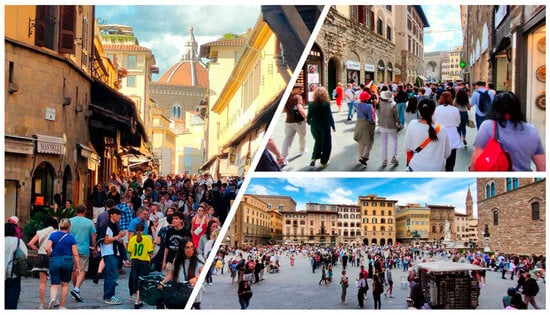
Figure 1.
The crowded streets of Florence. Photo by Authors.
We identified 65 different murals and graffiti pieces in the center of Florence (Figure 2). Some of them were repeated, while others featured multiple distinct artworks in a single location.
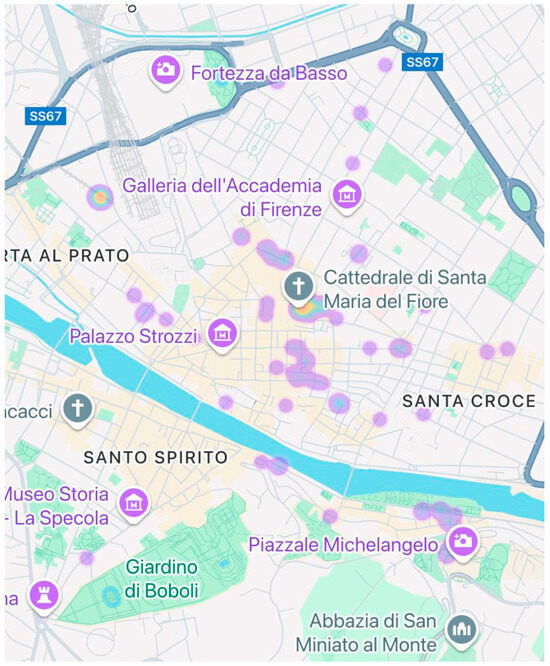
Figure 2.
Map highlighting locations of murals and graffiti. Source-Apple Maps.
4. Methodology
Street art, as a dynamic form of visual expression, represents a significant area of research into contemporary urban culture. This medium conveys social, cultural, and political messages, engaging residents and influencing their perception of public spaces (Pennycook 2022; Pogrmić and Đerčan 2021). Florence serves as a particularly notable example of street art’s impact-a city is probably visited annually by millions of tourists. The historic center of Florence, designated as a UNESCO World Heritage Site, functions as a vast open-air gallery. Within this space, contemporary street art interacts with Renaissance masterpieces and historic architecture, creating a unique contrast between tradition and modernity.
4.1. Research Question
This study focuses on a distinctive aspect of Florence’s street art: depictions of women. These works deliberately address themes related to femininity, women’s rights, violence, sexuality, and gender equality, aligning with global trends in feminist art and visual activism (Chung 2009; Val Fiel 2020).
The aim of our project was to explore the messages conveyed by street art depicting women to both Florence’s residents and the millions of tourists visiting the city annually. The research question was defined as: “What does street art in Florence depicting women aim to convey to its residents and tourists?” By posing this question, we sought not only to understand the local meanings embedded in Florence’s urban space but also to examine how these depictions contribute to global discourse on the social and cultural dimensions of femininity.
The choice to focus on the historic city center as the research area stemmed from the intensity and diversity of visual displays within this space and its unique role in shaping social perceptions at the intersection of global tourism and local cultural identity. This area serves as a site for dialogue between Renaissance traditions and contemporary forms of expression, enabling an analysis of the interactions between local narratives and global ideas regarding women’s roles in society.
4.2. Methodological Assumptions
This study employed qualitative content analysis based on the methodological framework proposed by Rose (2016). This approach involves systematically identifying, describing, and interpreting visual meanings while considering their social and cultural contexts. According to Rose’s concept, qualitative analysis goes beyond merely identifying visual content; it also interprets hidden meanings and those that emerge through interaction with the audience and the social space. In this way, content analysis transcends the description of visual elements, delving deeper into the semiotic and social mechanisms that shape the perception of images in public spaces.
A key step in the adopted methodology is the creation of coherent analytical categories (codes) that enable effective interpretation of the collected material. These categories must be detailed enough to capture the visual and thematic complexity of the phenomenon under study while remaining flexible enough to recognize subtle and contextual meanings within the images. For this project, we developed a coding system that encompassed both formal aspects of the works (technique, location, scale) and content-related elements (types of female representations, narrative context, symbolism). This allowed for a multidimensional analysis of the collected visual material.
We consciously chose not to use a quantitative approach focused on determining the frequency of specific codes. This decision was primarily driven by our research goal-to capture the interpretive richness, multidimensionality, and contextuality of meanings in Florence’s street art depicting women rather than merely measuring their prevalence. The qualitative approach enabled an in-depth interpretation of the analyzed artworks, considering their symbolic, social, and cultural meanings, which often elude purely statistical methods.
Rose’s methodology proved particularly effective for studying visual art within Florence’s urban context, where meanings are shaped at the intersection of creators, audiences, and the exhibition space itself. This approach allowed us to explore how Florence’s street art creates narratives about women that engage both local residents and international tourists. Consequently, we were able not only to identify dominant patterns of female representation in Florence’s urban art but also to interpret them within a broader context of Italian and European discourses on gender, public space, and socially engaged art.
4.3. Process of Collecting Visual Materials
Visual materials were gathered during a series of systematic field observations conducted in Florence’s city center in May 2024. The choice of this period was influenced by two key factors: increased tourist presence and heightened artistic activity in public spaces, which enabled us to collect a representative sample of contemporary street art works.
During fieldwork, dozens of photographs were taken of visual representations that met clearly defined selection criteria. These works:
- -
- Depicted women, either figuratively or symbolically;
- -
- Could be attributed to female artists based on style, signatures, or contextual clues;
- -
- Were located in Florence’s city center in public and accessible urban spaces with high foot traffic from residents and tourists (e.g., main streets, squares, building walls, or elements of urban infrastructure).
Each photographed work was meticulously documented digitally with appropriate technical parameters to facilitate subsequent analysis of visual content and its spatial context. The visual materials were archived systematically, with each entry labeled with the date of capture, exact location (geographical coordinates), and additional contextual information such as proximity to other visual elements or characteristics of the exhibition site. This organized archive provided a solid foundation for further stages of analysis.
The adopted photographic documentation method allowed for precise capture and preservation of street art’s ephemeral nature. Due to its transient character, street art is susceptible to changes caused by weather conditions, social reactions, or interventions by municipal authorities. This approach enabled not only recording the current state of artworks but also creating a lasting record for research purposes.
4.4. Categorization of Visual Materials (Code Creation)
In the next stage of analysis, based on a detailed review of the collected visual materials and consultations conducted by the research team, a set of analytical categories (codes) was developed to interpret the gathered data. The codes were selected to comprehensively and exhaustively reflect both the content and the socio-cultural context of depictions of women present in Florence’s urban space.
The following analytical categories were established:
- Depiction of action or protest-representations of women as active participants in social actions, public demonstrations, protests, or other forms of resistance against prevailing social norms.
- Depiction of violence, including sexual violence-visual portrayals of acts of aggression toward women, including both literal and symbolic references to physical, psychological, or sexual violence.
- Depiction of emotions-emotional expressions of female figures, capturing states such as joy, sadness, anger, fear, love, and other feelings conveyed through facial expressions, posture, or body language.
- Depiction of sexuality-representations containing sexual, erotic, sensual, or intimate elements, either explicitly or metaphorically suggested.
- Depiction of dominance or subordination-illustrations of power dynamics where female figures are clearly depicted as dominant or subordinate to other characters or social situations.
- Depiction of human rights issues-references to topics related to women’s rights and freedoms, including equality, dignity, personal safety, and minority rights.
- Depiction of religion-the presence of religious or spiritual symbols, references to religious practices, or interactions between female figures and religious contexts.
- Depiction of gender equality or inequality-representations that explicitly address gender equality issues or highlight social inequalities between women and men.
- Depiction of agency-portrayals of women as active agents in their own life decisions, influencing their surroundings and shaping reality independently.
- Depiction of clothing-focus on attire, fashion styles, and their symbolic, social, and cultural significance in the context of female identity.
- Depiction of nudity-representations of women in a state of nudity, analyzed within artistic, naturalistic, or erotic contexts along with their meanings and implications.
- Depiction of scenery (context)-analysis of surroundings such as urban spaces, landscapes, or other background visual elements that contribute to the meaning of depicted women.
- Depiction of social roles-illustrations showing women in specific social roles such as mother, activist, artist, or leader within family, professional, or cultural contexts.
- Depiction of material status-visual references indicating economic or social status through attributes like luxury items, poverty markers, or lifestyle indicators.
- Depiction of relationships between female figures and others-representations showing interactions between women and other individuals in interpersonal relationships such as family ties, friendships, social connections, or romantic interactions.
Each category was thoroughly defined and discussed during the preparatory phase to ensure clarity and interpretative consistency in subsequent stages of analysis. The codes were designed to be flexible enough to capture both explicit meanings and subtler symbolic content characteristic of the street art medium under study.
This systematic categorization allowed for a nuanced interpretation that encompassed both straightforward visual elements and deeper socio-cultural narratives embedded in Florence’s urban art depicting women.
4.5. Coding Procedure
The analysis of the collected visual material was conducted over several analytical sessions involving the entire research team. Each session consisted of a detailed, collaborative discussion of selected photographs, which allowed for an in-depth understanding of the analyzed material and minimized the risk of subjective interpretations arising from individual researchers’ perspectives.
The coding process was systematic and organized. All images were analyzed sequentially according to the previously developed analytical categories (codes). Each visual representation was assigned to one or more categories based on their detailed definitions. This approach enabled a multidimensional analysis of street art content, taking into account both the complexity of visual messages and their diversity.
To ensure a high level of reliability and objectivity in the interpretative process, a team-based approach grounded in interpretative triangulation was employed. Each photograph was discussed collectively by the entire research team, and any discrepancies in interpretation were immediately identified and subjected to thorough discussion. In cases of differing opinions regarding visual meanings, decisions were made collectively, with the aim of reaching a consensus. This procedure minimized errors stemming from individual subjective assessments while ensuring consistency and transparency in the coding process.
Each analytical session was meticulously documented in the form of notes containing interpretative comments and team decisions regarding the assignment of images to specific analytical codes. This documentation played a key role in the later phase of interpreting results, enabling a comprehensive and in-depth analysis of the visual material. Through this process, it was possible to draw reliable final conclusions that accounted for both the visual and spatial contexts of the analyzed representations.
4.6. Example of Coding
Below, we present as an example notes concerning the street art indicated in Figure 3 (murals depicting a female figure wearing a veil):
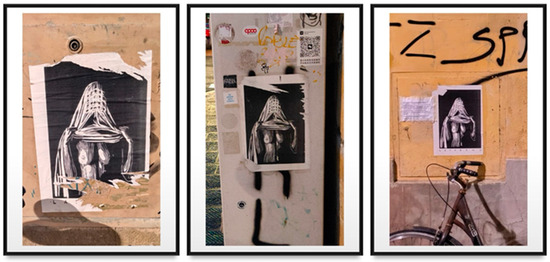
Figure 3.
Murals depicting a female figure wearing a veil. Photo by Authors.
- Depiction of action, including protest:The painting depicts a figure with her face covered, which may suggest a form of protest or a symbolic concealment of identity. The motif of covering the face can refer to restrictions on freedom or issues related to the role of women in society, particularly in Islamic countries.
- Depiction of violence, including sexual violence:There is no direct depiction of violence; however, the way the figure is presented-seemingly trapped under the veil-can evoke associations with oppression, enslavement, or restrictions imposed on women.
- Depiction of emotion:The figure is difficult to interpret unambiguously due to her covered face, which may be a deliberate choice intended to evoke a sense of mystery, sadness, or helplessness.
- Depiction of sexuality:The painting shows a naked woman with a veil covering her head and face, introducing elements of sexuality. The naked body is clearly visible, but it is not portrayed in a vulgar way; rather, it is presented in the context of symbolic isolation and resistance to the attire imposed by Islamic culture.
- Depiction of dominance or subordination:The motif of the covered face suggests subordination, most likely enforced by society, cultural norms, or religion. This can be interpreted as a symbolic reference to restrictions placed on the individual, particularly women.
- Depiction of human rights issues:The painting may address the topic of human rights, especially women’s freedom and their right to self-expression. The covered face may symbolize the restriction of personal freedom.
- Depiction of relationship with religion:Covering the face with a veil may refer to religious norms requiring the concealment of parts of the body, suggesting a connection with religious interpretations of women’s roles. It may also be a critique of such norms.
- Depiction of gender equality (or lack thereof):The painting emphasizes gender imbalance by showing a naked woman with her face covered, suggesting subordination or the suppression of her identity. The hidden face is a key element that influences the perception of the figure as enslaved.
- Depiction of agency:The figure in the painting lacks agency-she is passive, covered, and stripped of individuality. This is a symbolic image that depicts subordination rather than active agency.
- Depiction of clothing:The figure is naked; the only element of “clothing” is the veil covering her face. This contrast between the naked body and the covered face carries strong symbolic meaning.
- Depiction of nudity:Nudity in this painting is presented in a stark manner-not to evoke eroticism, but rather to highlight the fragility and vulnerability of the figure. This nudity is meant to prompt reflection on her situation, not to provoke with sexuality.
- Depiction of scenery:There is no distinct scenery; the background is uniform, focusing attention on the figure. This minimalist approach ensures that the viewer concentrates on the message.
- Depiction of social role:The figure may symbolize the role of women in society, especially in the context of restrictions on freedom and self-expression. The hidden face under the veil is a symbolic expression of a lack of individuality and submission to social norms.
- Depiction of material status:There are no elements indicating the material status of the figure. The minimalist style and lack of accessories suggest that the main theme of the painting is identity and freedom rather than material status.
- Depiction of the figure’s relationship with others:The painting does not show any other figures, only a solitary, veiled person. This introduces a sense of isolation, loneliness, and separation from society, further strengthening the symbolic message of the work.
The painting signed “Lasudama” depicts a naked figure whose face is covered by a veil. This manner of representation can be interpreted as a critique of social and religious norms that restrict women’s freedom. The symbolism of the painting is strong, addressing issues related to identity, subordination, and personal freedom.
4.7. Analysis of Results
The collected and coded visual materials were subjected to an in-depth qualitative analysis, enabling a detailed interpretation of the meanings conveyed by street art on two interdependent levels:
- -
- Semiotic level-at this level, symbolic elements within the representations were analyzed, including signs, metaphors, allegories, and their visual and spatial relationships. This process involved deconstructing the hidden meanings embedded in individual artworks and interpreting their symbolism to understand the messages conveyed to the audience through street art. The semiotic analysis revealed deeper layers of meaning within the works and their communicative potential.
- -
- Cultural–social level-at this level, the interpretation focused on examining how depictions of women fit into broader social and cultural discourses. Topics such as female identity, women’s rights, gender equality, violence against women, and perceptions of women by both the local community and the international tourist audience visiting Florence were explored. This dimension of analysis contextualized the artworks within global feminist and emancipatory narratives.
The analysis determined that Florence’s street art exhibits a consciously interventionist and socially engaged character. Many of the analyzed representations explicitly challenge cultural stereotypes about women as well as socio-political issues such as gender inequality, discrimination, human rights, and violence against women. Importantly, these messages are often rooted in Florence’s local context while simultaneously engaging with global feminist and emancipatory narratives, resonating with both city residents and a broad tourist audience.
These representations, due to their visibility in urban spaces and use of symbolic visual language, influence tourists’ perception of the city while encouraging local residents to reflect on critical social issues and their manifestation in everyday public spaces. In this way, women’s street art in Florence serves not only an artistic function but also an educational and socio-critical role. It becomes a significant tool for cultural communication in urban spaces, bridging local and global perspectives and engaging audiences in dialogue about pressing social issues.
4.8. Ensuring Research Reliability
To guarantee the reliability, credibility, and transparency of the applied research approach, we implemented a set of procedures and control mechanisms typical for qualitative studies in visual content analysis. Specifically, the following strategies were employed:
- -
- Team triangulation-each visual analysis was conducted during team sessions, where all members of the research group jointly interpreted and discussed the collected material. Repeated collaborative analyses and discussions helped reduce one-sided evaluations and minimized errors resulting from individual interpretative biases.
- -
- Precise definitions of analytical codes-before starting the analysis process, each analytical code was thoroughly described and explained. Clear definitions and operationalization of analytical categories ensured consistency in the coding process and provided repeatability and reliability in the results obtained.
- -
- Regular documentation of the analytical process-each analytical session was meticulously documented through detailed notes containing information about the course of discussions, interpretations of individual images, and decisions regarding coding. The documentation also included archiving photographs with marked elements of analysis, allowing for later verification or repetition of the analytical process.
- -
- Mutual verification of interpretations-each image interpretation was subjected to mutual verification by the research team members. In cases of doubts or discrepancies in interpretation, in-depth discussions were conducted to reach a consensus. This process enhanced the credibility of the results, ensuring that the interpretations derived were a product of collective effort rather than individual research preferences.
The application of these strategies enabled a reliable and transparent qualitative analysis. The results obtained through this process can be considered credible and valuable in the context of research on street art in urban spaces.
4.9. Research Limitations
Despite employing a carefully designed research procedure, we acknowledge certain methodological limitations that may have influenced the process and interpretation of the results obtained. The key limitations of this study include:
- -
- Subjectivity of interpretation-qualitative analysis, particularly concerning visual materials, inherently involves a degree of subjectivity. Although the risk of errors stemming from individual interpretative biases was minimized through team triangulation and mutual verification procedures, it is impossible to completely eliminate interpretative elements. Subjectivity remains an inherent aspect of qualitative research approaches.
- -
- Incomplete representativeness of the sample-the research material was collected exclusively within Florence’s city center, which may limit the representativeness of the findings. The city center, due to its touristic and commercial nature, favors certain themes, motifs, or artistic forms being showcased. As a result, the study’s findings may not fully reflect the thematic and visual diversity of street art across the entire city.
- -
- Ephemeral nature of street art-the transient nature of the analyzed material poses a significant limitation to this study. Street art, as a form of urban art, is often subject to rapid and unpredictable changes caused by municipal actions, weather conditions, or other artists’ activities. Some works may have disappeared, been modified, or replaced entirely by new creations after the material collection process concluded. Such changes make it impossible to verify or reanalyze them in the future.
While these limitations are significant, they do not diminish the cognitive value of this study. Instead, they highlight key aspects that should be considered during result interpretation and point to potential areas for further in-depth research on street art and women artists’ roles in public spaces. Addressing these limitations in future research projects could contribute to an even more comprehensive understanding of street art’s socio-cultural significance and its dynamics within urban contexts.
One of the methodological challenges was identifying the gender of the creators of individual works. In cases where there were no clear signatures or information available on social media, we relied on the analysis of style, subject matter, and the context in which the work was created. However, we are aware that this method carries a risk of error and does not always allow for unambiguous attribution of authorship. In future research, it would be worth considering direct contact with the artists or conducting in-depth ethnographic studies to better understand their intentions and experiences.
It is also worth emphasizing that some of the works analyzed are not unique to Florence-similar motifs and styles can likely be found in other Italian cities. Often, the artists are “tourists” or temporary residents, which raises the question of the local identity of street art. Here, we understand “Florentine street art” as works present in the city’s public space, regardless of the origin of their creators.
5. Research Findings
Street art in Florence, as a vibrant element of the urban landscape, reflects diverse socio-cultural themes that address both local identity and contemporary global issues. Analyzing images depicting women reveals a multifaceted and complex narrative. The aim of this analysis is to synthesize the dominant motifs, aesthetics, and social relationships in Florentine street art while understanding its communicative function-both for the city’s residents and its tourists. The central theme of this study is femininity in street art. While we attempted to identify as many works depicting women as possible, we acknowledge that we were unable to create a comprehensive catalog of these artworks. Our approach is qualitative and does not include quantitative analysis.
The findings indicate that women depicted in Florentine street art are not merely aesthetic objects; they serve as active participants in urban narratives. In many works by street artists, women are portrayed as figures of struggle-leaders, warriors, and individuals breaking stereotypical social roles. They are presented as strong personalities who have a tangible impact on the urban space. Importantly, their visual appeal often seems directed at themselves-as an expression of self-acceptance-rather than as objects of male fascination or subjects subordinate to male dominance.
A distinctive feature of these representations is their placement within the context of contemporary global challenges. Florentine street art often serves as a form of protest against over-tourism, urban chaos, or political repression. Female figures frequently symbolize defenders of local autonomy and identity, becoming icons of resistance and resilience. They represent not only individual issues but also the challenges faced by entire communities. Assigning women the role of protagonists in the fight for city rights, public spaces, and residents’ quality of life offers a novel way to interpret Florence’s urban landscape.
Some artworks address intimacy in paradoxical ways-combining it with distance. Motifs such as masked figures kissing illustrate the tension between the need for closeness and the necessity of maintaining distance (Figure 4).
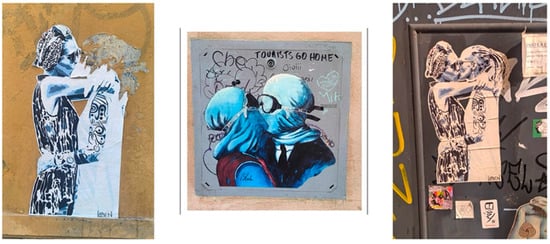
Figure 4.
Murals depicting kissing figures. Photo by Authors.
This interplay between intimacy and alienation becomes apparent in the emotional contexts of the images, which convey both love and the need to establish boundaries. Some murals highlight female nudity, not to provoke eroticism but as a manifesto of freedom and vulnerability (Figure 5).
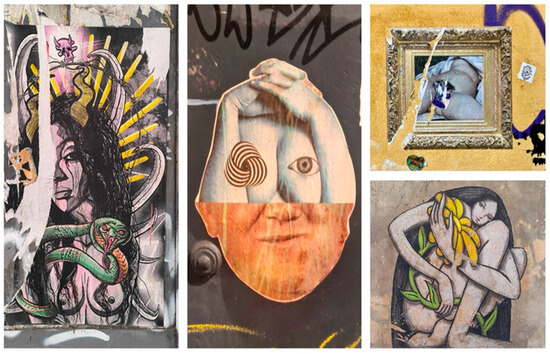
Figure 5.
Murals highlighting female nudity. Photo by Authors.
Surrealist depictions of women-often distorted or placed in unusual visual contexts-serve as commentary on the emotional and psychological burdens of contemporary urban life. Artists use surrealism to highlight issues such as the dehumanization of interpersonal relationships and difficulties stemming from living in a world dominated by social norms, economic crises, and political challenges. These images encourage viewers to reflect on how modern cities can become spaces of alienation and how individuals strive to find their place within them without losing their need for emotional connection.
Florentine street art often uses female figures as a medium to address oppression imposed by culture or religion (Figure 6). These works act as catalysts for social change, sparking reflection on human rights, individual autonomy, and freedom to live according to one’s beliefs. Female figures not only affirm femininity but also emphasize its multidimensional nature-full of tenderness and intimacy but also resistance and struggle for one’s place in the world.
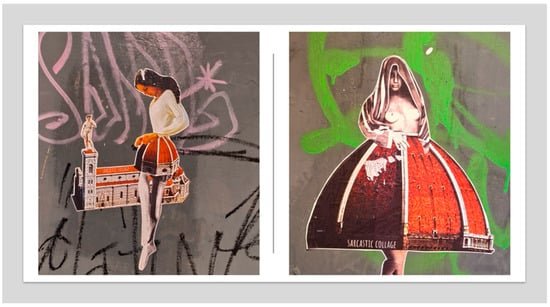
Figure 6.
Murals combining the image of a woman with the Florence cathedral. Photo by Authors.
Florentine street art creates a dynamic, complex, and contradictory image of women, which lends it authenticity and expressive power. While the messages embedded in these works are rooted in Florence’s local context, they carry universal significance. Female figures depicted in murals are not only part of Florence’s urban landscape but also representations of global challenges faced by women worldwide. This art speaks of agency and limitations, beauty and struggles-making it both socially significant and universally resonant.
The aesthetics of Florentine street art stand out for their rich use of color, skillful application of contrasts, and meaningful symbolism (Figure 7). Color plays a key role in conveying the emotional messages of the works. Predominant hues such as intense reds, shades of blue, and black-and-white compositions carry specific meanings. Vibrant colors often express rebellion, struggle, or resistance, while subdued palettes suggest introspection and tranquility.
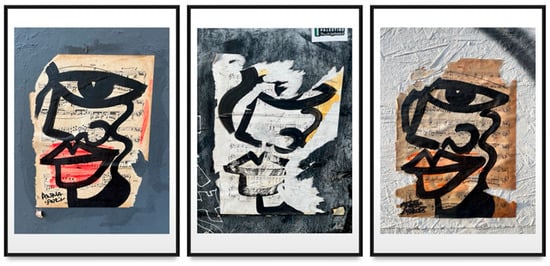
Figure 7.
Mural featuring a woman’s face against a musical score background. Photo by Authors.
Florence-a city historically associated with Renaissance art dominated by men-has become a space where street art highlights the role of women in contemporary society. Some works reference classical motifs but reinterpret them in modern ways, portraying women as strong and independent individuals often liberated from traditional roles and expectations. This celebration of femininity is also reflected in the stylistic choices: bold colors, striking contrasts, and surreal elements give female figures added prominence and strength.
The aesthetics of street art in Florence cannot be considered without acknowledging its relationship with the urban environment. The city itself functions as an open gallery steeped in history and tradition, providing a remarkable backdrop for contemporary murals. In this context, Florentine street art becomes a dialogue between past and present. Works placed on building walls, alleyways, or near major tourist attractions interact with their surroundings-some appear “integrated” into the city’s architecture as if they were natural extensions of it. These pieces not only adorn urban spaces but also emphasize their significance, becoming part of Florence’s narrative that bridges tradition with modernity.
Conversely, other works starkly contrast with their environment-bright colors, modern techniques, and dynamic depictions stand out against the muted façades of historical buildings. This contrast amplifies the messages conveyed by the artworks, turning them into visual “cries” demanding attention and reflection. Placing such pieces in locations frequented by tourists transforms them into a form of communication with a broad international audience.
Techniques employed by Florentine street artists range from classic graffiti and collages to more traditional mural painting methods. Artistic styles often reflect the creators’ intentions: aggressive, dynamic lines accompany messages filled with rebellion and protest, while softer forms characterize works addressing intimate themes. The diversity of aesthetic approaches enriches the city’s visual landscape and communicates a wide array of women’s experiences-from fighting for their rights to introspective reflections on daily life (Figure 8 and Figure 9).
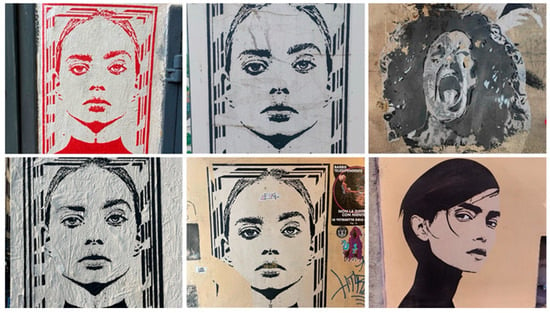
Figure 8.
Murals featuring women’s faces. Photo by Authors.
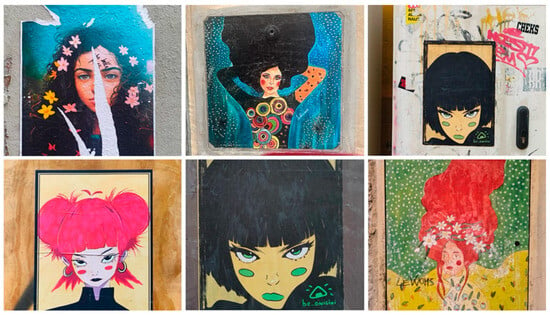
Figure 9.
Murals depicting women’s faces in a colorful setting. Photo by Authors.
An intriguing aspect of Florentine street art is the distinction between personal works and those intended for broader audiences. Intimate pieces focus on emotions such as sadness, joy, or longing and are marked by subtlety and detailed complexity. In contrast, protest-oriented artworks aim to provoke social reactions-their style is simpler, clearer, and visually impactful.
Florentine street art depicting female figures serves not only an aesthetic purpose but also social and political functions. Women portrayed in this art symbolize resilience, strength, and resistance to contemporary challenges-from over-tourism to political crises or the need to preserve intimacy in a world full of constraints. These works address issues such as human rights and individual autonomy, acting as catalysts for reflection and social change.
Thanks to its accessibility to all-both residents and tourists-Florentine street art acquires a democratic dimension. Pieces displayed on building walls or urban infrastructure become part of pedestrians’ daily lives. Female figures depicted in murals not only beautify the city but also actively participate in its narrative-calling for reflection on women’s place in society and their relationship with the surrounding world.
Florentine street art creates a dynamic and multifaceted image of women-full of contradictions, authenticity, and expressive power. The message carried by these works has a universal character: it showcases women’s beauty and strength as well as their struggles with contemporary challenges. Each piece is a kind of manifesto-sometimes personal, sometimes social-that reminds us of the power of street art as a medium capable of shaping reality, building community, and inspiring action.
Florentine street art depicting women stands out not only for its diversity of motifs but also for its complex communicative layer, which engages viewers on multiple levels. One significant aspect is the way these representations negotiate the visibility of women in public space. In many cases, female artists consciously abandon classical canons of beauty or traditional gender roles, presenting female figures as autonomous, complex, and ambiguous. Such visual strategies challenge entrenched stereotypes and simultaneously open up space for the redefinition of female identity in the urban context (Figure 10 and Figure 11). For example, the presence of female figures in leadership, activist, or rebellious roles breaks with the image of women as passive objects of the gaze and emphasizes their agency and capacity to initiate social change.
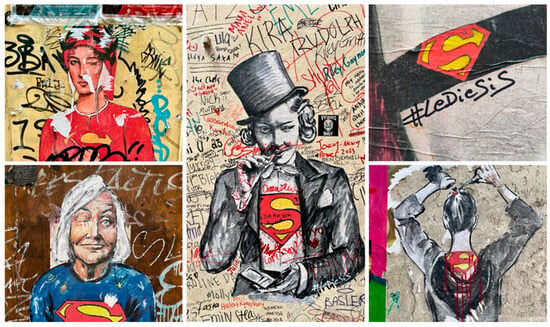
Figure 10.
Murals featuring the superwoman motif. Photo by Authors.
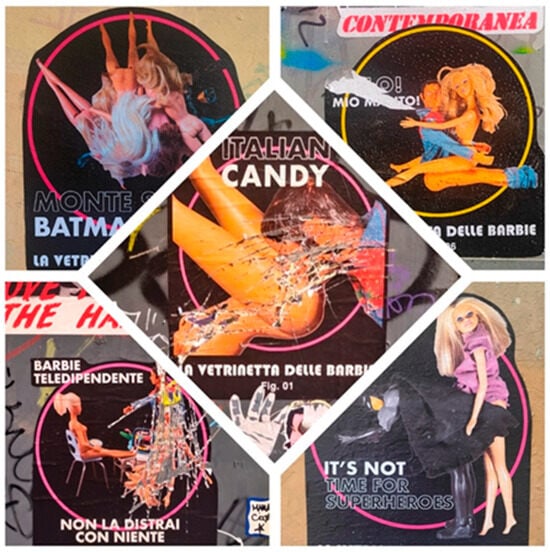
Figure 11.
Murals challenging the depictions of superheroes. Photo by Authors.
Another dimension of analysis is the dialogue these works maintain with Florence’s historical heritage. In a city whose artistic identity for centuries was shaped almost exclusively by men, street art becomes a tool for the symbolic “reclaiming” of space by women. Many murals consciously reference Renaissance iconography-however, reinterpreted from a feminist perspective. The artists not only “inscribe themselves” into tradition but also transform it: juxtaposing classical motifs with modern aesthetics, combining elements of the past with current social issues. In this way, a multilayered message emerges, in which women are no longer merely marginal figures in the historical landscape but become central protagonists of contemporary urban narratives. This strategy not only enhances their visibility but also provokes viewers to reflect on who has the right to representation and to co-create urban identity.
It is also worth noting the aspect of interaction between these works and their audience. Murals and graffiti, placed in spaces accessible to all, become an everyday element of the landscape-their message is not reserved for an elite visiting museums but reaches a broad group of residents and tourists. Thanks to this, street art gains educational and mobilizing potential: it provokes discussion, inspires action, and sometimes even initiates local debates on equality, violence, or human rights. In this way, street art not only beautifies the city but also actively participates in the process of building a more inclusive and conscious community.
When analyzing the communicative nature of street art, it should be noted that not all works have a clear narrative message. Non-communicative tags or inscriptions are also a form of women’s presence in public space, although their interpretation requires different research tools. It is also important to critically reflect on the relationship between street art and tourism. In cities like Florence, street art is sometimes used as a tool for tourism promotion, which can lead to gentrification and the displacement of local residents. At the same time, the presence of feminist-themed street art can be both a form of resistance and part of the city’s marketing strategies. Similar processes can be observed in London, Berlin, or Barcelona. Furthermore, it should be noted that, in the analyzed works, there is little or no representation of certain groups of women, such as Black women, migrants, elderly women, or women with experiences of poverty. The absence of these themes prompts reflection on which stories remain invisible in the urban space of Florence.
6. Summary
Useful for analyzing the phenomena of street art is a reference to Henri Lefebvre’s concept of the “right to the city” which is understood not merely as the right to physically inhabit the city, but above all as the right to actively co-create and make use of urban space-its rhythms, resources, and symbolism. Lefebvre emphasizes that this right should include all residents, not just privileged elites. The right to the city encompasses the right to participate in decision-making processes regarding the city, as well as the right to appropriation of space-not in the sense of private ownership, but in terms of its use, experience, and the assignment of meaning. In this concept, Henri Lefebvre points out that the city should be treated as the collective work (oeuvre) of all its inhabitants, not as a market product (Lefebvre 1996). Thus, street art can be seen as a practical realization of Lefebvre’s postulate that the city should be the work of everyone, not just a product for the select few. Street artists often appropriate public space, give it new meanings, and express the diversity of urban experiences-exactly as Lefebvre advocated in relation to the right to the city.
In recent years, research on street art and graffiti has taken on a strongly interdisciplinary and intersectional character, particularly in the context of gender, race, and urban economics. Jessica Pabón-Colón, in her work “Graffiti Grrlz” (Pabón-Colón 2018), emphasizes that women are redefining both artistic practices and the very concepts of femininity and masculinity in public spaces, often employing performativity and collective strategies. Sinno (2024) analyzes how feminist street art becomes a tool of political resistance and community building, especially in contexts of conflict and marginalization. Meanwhile, Griffin (2019) demonstrates that, in cities such as Bogotá, street art serves as a means of negotiating urban imaginaries and combating structural violence against women and LGBTQ+ individuals. Bruce (2024) draws attention to the complex power relations revealed in murals and graffiti in Mexico, where women artists often remain invisible or marginalized by dominant narratives.
In light of the concept of the “right to the city,” street art appears as a practical realization of this idea. Street artists, through their actions, both symbolically and literally “appropriate” public space, giving it new meanings and opening it up to voices that have previously been marginalized. Their creativity often goes beyond the boundaries of traditional art, provoking reflection on who has the right to visibility, expression, and decision making in urban space. In the case of Florence-a city with a deeply rooted artistic tradition-street art becomes a tool for negotiating identity, connecting heritage with modernity, and including previously invisible groups in the urban discourse.
One of the key conclusions drawn from the analysis is the significant role street art plays in creating a dialogue between tradition and modernity. Florence, a symbol of Renaissance heritage, does not confine itself to its past but embraces new forms of artistic expression. Murals and graffiti depicting women interact with the city’s architecture, transforming walls and alleyways into canvases where artists address topics relevant to the local community. The integration of street art into Florence’s historic space creates a multidimensional message that speaks to both local identity and universal values such as equality, autonomy, and human rights advocacy.
The depictions of women can be interpreted as an attempt to reclaim public spaces for groups marginalized for centuries. Their presence in the urban landscape serves as a form of resistance against the patriarchal history of art and affirms femininity as a value deserving visibility and a central place in social discourse. Florentine street art not only beautifies the city but also raises questions about belonging, representation, and control over urban spaces.
What sets street art apart from works displayed in galleries like the Uffizi or Palazzo Pitti is its openness to reinterpretation. Unlike museum-protected pieces, street art is vulnerable to vandalism or alterations that may modify its original message. Sometimes these changes can be seen as a form of “continuation,” akin to Marcel Duchamp’s act of painting a mustache and goatee on Leonardo da Vinci’s “Mona Lisa.” In the context of street art, such actions shift emphasis from creators to their works as dynamic carriers of meaning. These pieces play a crucial role in redefining urban spaces and shaping the city’s modern identity.
Florentine street art, especially those depicting female figures, serves as a powerful medium of social, aesthetic, and political expression. The analysis reveals the complexity, multifaceted nature, and diversity of messages embedded in these works by artists. Women portrayed in murals and graffiti are not merely aesthetic elements of the urban landscape but also social symbols-representing struggles for autonomy, public space rights, and agency in a globalized world. This art becomes an integral part of Florence’s urban fabric, where tradition merges with modernity, and historical buildings provide a backdrop for contemporary challenges and aspirations.
Street art in Florence influences how both residents and tourists perceive urban spaces. For local communities, murals act as visual manifestos reminding them of their identity’s value and potential for social change. For tourists, these works offer more than beautiful sights-they present an unexpected perspective on Florence as a living organism full of contemporary challenges, desires, and struggles. The sight of female figures on walls surrounded by monumental Renaissance buildings reveals a dynamic city that does not remain frozen in time but actively seeks new forms of expression while reshaping its identity through dialogue with the world.
Street artists initiate debates on issues important to both local communities and global audiences. As awareness grows around topics such as climate change, social inequality, or violence against women, Florentine street art is expected to play an increasingly significant role as a tool for education and social mobilization. For many tourists, street art becomes an unexpected discovery that adds context to their visit to the city. Contemporary murals allow visitors to see Florence not only as a museum of history but also as a space actively responding to modern challenges.
In conclusion: through their works, artists embed women into urban spaces on equal footing with men-and often place them at the center as active figures influencing the surrounding world. This message is crucial for shaping social awareness among both Florentine residents and visiting tourists. These works not only reflect individual stories and emotions but also resonate with the experiences of local communities, making them carriers of collective values. They portray women as full participants in social life-individuals with their rightful place at the heart of the city.
Florentine street art is more than decoration-it is a visual manifestation of social and political discourse that transforms the city and shapes its identity in bold new ways. In this context, it can be seen as a form of resistance (Awad et al. 2017). It is art with educational and social dimensions-demanding justice while engaging viewers to reflect on contemporary issues.
Author Contributions
Conceptualization, A.C. and M.P.; methodology, A.C. and M.P.; software, A.C. and M.P.; validation, A.C. and M.P.; formal analysis, A.C. and M.P.; investigation, A.C. and M.P.; resources, A.C. and M.P.; data curation, A.C. and M.P.; writing-original draft preparation, A.C. and M.P.; writing-review and editing, A.C. and M.P.; visualization, A.C. and M.P.; supervision, A.C. and M.P.; project administration, A.C. and M.P. All authors have read and agreed to the published version of the manuscript.
Funding
This research was funded by: GRANT OFFER: Research Grant, Other JeS Guarantee Calls, GRANT TITLE: Communities and Artistic Participation in Hybrid Environment, (CAPHE). Grant Ref: EP/X038572/1. HORIZON-MSCA-SE-202101-01 grant agreement Communities and Artistic Participation in Hybrid Environment, No. 101086391 and Research Grant, Other JeS Guarantee Calls, as well as by the University of Szczecin.
Data Availability Statement
The data presented in this study are available on request from the corresponding author due to the sensitivity of the research.
Conflicts of Interest
The authors declare that they have no conflicts of interest.
References
- Abram, Sandi. 2024. Graffiti, street art and murals against the neoliberal city: Wall-written dissensus. Street Art & Urban Creativity 10: 54–71. [Google Scholar] [CrossRef]
- Alizadeh, Hooshmand, Josef Kohlbacher, Rozhen Kamel Mohammed-Amin, and Tabin Latif Raouf. 2021. Gender inequalities and the effects of feminine artworks on public spaces: A dialogue. Social Inclusion 9: 158–67. [Google Scholar] [CrossRef]
- Awad, Sarah H., Brady Wagoner, and Vlad Glaveanu. 2017. The (street) art of resistance. In Resistance in Everyday Life: Constructing Cultural Experiences. Edited by Nandita Chaudhary, Pernille Hviid, Giuseppina Marsico and Jakob Waag Villadsen. New York: Springer. [Google Scholar]
- Beattie, Alix Maria. 2017. Women on Walls: Engaging Street Art Through the Eyes of Female Artists. Master’s thesis, Western Sydney University, Sydney, Australia. Available online: https://researchers-admin.westernsydney.edu.au/ws/portalfiles/portal/94892432/uws_45808.pdf (accessed on 20 November 2024).
- Berg, Linda, and Anna Sofia Lundgren. 2021. We Were Here, and We Still Are: Negotiations of Political Space Through Unsanctioned Art. In Pluralistic Struggles in Gender, Sexuality and Coloniality. Edited by Erika Alm, Linda Berg, Mikela Lundahl Hero, Anna Johansson, Pia Laskar, Lena Martinsson, Diana Mulinari and Cathrin Wasshede. Cham: Palgrave Macmillan, pp. 49–80. [Google Scholar] [CrossRef]
- Bruce, Caitlin Frances. 2024. Voices in Aerosol: Youth Culture, Institutional Attunement, and Graffiti in Urban Mexico. Austin: University of Texas Press. [Google Scholar]
- Castro, Isabel Carrasco, and Stelle Confuse. 2020. Aroldo Marinai’s Frogmen project: A pioneer of street art in Florence. SAUC-Street Art & Urban Creativity Scientific Journal 6: 96–108. [Google Scholar]
- Chung, Sheng Kuan. 2009. An art of resistance from the street to the classroom. Art Education 62: 25–32. [Google Scholar] [CrossRef]
- Fleischmann, Katja, and Robert H. Mann. 2018. Women on walls: The female subject in modern graffiti art. eTropic: Electronic Journal of Studies in the Tropics 17: 83–109. [Google Scholar] [CrossRef]
- Fransberg, Malin. 2018. Performing gendered distinctions: Young women painting illicit street art and graffiti in Helsinki. Journal of Youth Studies 22: 489–504. [Google Scholar] [CrossRef]
- Griffin, Alba. 2019. Reading the Walls in Bogotá: Imaginaries of Violence in the Urban Visual Landscape. Doctoral dissertation, Newcastle University, Newcastle, UK. [Google Scholar]
- Grossman-Thompson, Barbara, and Charlotta Salmi. 2021. Kathmandu’s Street Art: Public Representations of Gendered Vulnerability. Signs: Journal of Women in Culture and Society 46: 589–614. [Google Scholar] [CrossRef]
- Hamann, Cristiano, João G. M. Cardoso, Pedro de Castro-Tedesco, and Adolfo Pizzinatode. 2013. Entre o público e o privado: Discurso de mulheres em movimentos de grafite. Ex Aequo (Oeiras) 28: 45–58. [Google Scholar]
- Heyd, Theresa, and Alexsandra Karnatz. 2020. Handstyle as social meaning: Graphic variation, graffiti and gender. Ampersand 7: 100063. [Google Scholar] [CrossRef]
- Hvala, Tea. 2008. Streetwise Feminism Feminist and Lesbian Street Actions, Street Art and Graffiti in Ljubljana. Amnis: Revue de Civilisation Contemporaine de l’Université de Bretagne Occidentale 8: 3. [Google Scholar] [CrossRef]
- Lefebvre, Henri. 1996. Writings on Cities. Oxford: Blackwell. [Google Scholar]
- Mattar, Daniela Vicherat. 2024. Public spaces, street art, and the challenges of feminist ecological citizenship in Chile. Gender & Development 32: 71–91. [Google Scholar] [CrossRef]
- Mitchell, William John Thomas. 2005. What Do Pictures Want? The Lives and Loves of Images. Chicago: University of Chicago Press. [Google Scholar]
- Pabón, Jessica Nydia. 2016. Ways of being seen: Gender and the writing on the wall. In Routledge Handbook of Graffiti and Street Art. Edited by Jeffrey Ian Ross. New York: Routledge, pp. 78–91. [Google Scholar]
- Pabón-Colón, Jessica Nydia. 2018. Graffiti Grrlz: Performing Feminism in the Hip Hop Diaspora. New York: New York University Press. [Google Scholar]
- Pennycook, Alastair. 2022. Street art assemblages. Social Semiotics 32: 563–76. [Google Scholar] [CrossRef]
- Pinto, Sofia. 2020. Why can’t Banksy be a woman? The gendering of graffiti and street art atudies. Street Art & Urban Creativity 6: 6–11. [Google Scholar] [CrossRef]
- Pogrmić, Zorica, and Bojan Đerčan. 2021. The role of Street art in urban space recognition. Zbornik Radova Departmana za Geografiju, Turizam i Hotelijerstvo 50–52: 122–31. [Google Scholar] [CrossRef]
- Rajan, Benson. 2021. Sari, femininity, and wall art: A semiotic study of guess. Who’s street art in Bengaluru. Tripodos. Facultat de Comunicació i Relacions Internacionals Blanquerna-URL 50: 111–30. [Google Scholar] [CrossRef]
- Reka, Deniz. 2021. Feminist aktivizmin temsil alanı olarak sanat: Guerrilla Girls. Yedi: Sanat, Tasarım ve Bilim Dergisi 26: 131–44. [Google Scholar] [CrossRef]
- Rojek, Karolina. 2020. The feminist street art from the western part of Mexico. Quart 58: 76–91. [Google Scholar] [CrossRef]
- Rose, Gillian. 2016. Visual methodologies. In An Introduction to Researching with Visual Materials, 4th ed. Los Angeles, London and New Delhi: SAGE Publications Ltd. [Google Scholar]
- Sapentri, Evan. 2020. “Jika Dinding Bisa Berbicara?” Street Art dan Representasi Perempuan dalam Karya-karya Stensil Digie Sigit. Melayu Arts and Performance Journal 3: 1–13. [Google Scholar] [CrossRef]
- Sinno, Nadine A. 2024. A War of Colors. Austin: University of Texas Press. [Google Scholar]
- TVN. 2023. Wielotysięczne manifestacje we Włoszech przeciwko fali przemocy wobec kobiet. Available online: https://tvn24.pl/swiat/wlochy-manifestacje-przeciwko-fali-przemocy-wobec-kobiet-st7455181 (accessed on 27 May 2024).
- Val Fiel, Monica. 2020. Symbolic learning in the city. Street art in the regeneration of public space. Disegnarecon 13: 1–14. [Google Scholar] [CrossRef]
- Valjakka, Minna. 2019. Worlding through gendering: Female agency, artistic practices and spatio-aesthetic dynamics in and for cities. City, Culture and Society 19: 100283. [Google Scholar] [CrossRef]
- Wei, Wei. 2015. Street, behavior, art: Advocating gender rights and the innovation of a social movement repertoire. Chinese Journal of Sociology 1: 279–304. [Google Scholar] [CrossRef]
- Wysocka, Sylwia. 2023. Femminicidio, Czyli Zabojstwo Kobiety Włoskim Słowem 2023 Roku, PAP 28.12.2023. Available online: https://www.pap.pl/aktualnosci/femminicidio-czyli-zabojstwo-kobiety-wloskim-slowem-2023-roku (accessed on 27 May 2024).
- Zojaji, Negar. 2021. (Un)making Femininity on the Walls of Tehran. SAUC-Street Art and Urban Creativity (Repository) 7: 34–47. [Google Scholar] [CrossRef]
Disclaimer/Publisher’s Note: The statements, opinions and data contained in all publications are solely those of the individual author(s) and contributor(s) and not of MDPI and/or the editor(s). MDPI and/or the editor(s) disclaim responsibility for any injury to people or property resulting from any ideas, methods, instructions or products referred to in the content. |
© 2025 by the authors. Licensee MDPI, Basel, Switzerland. This article is an open access article distributed under the terms and conditions of the Creative Commons Attribution (CC BY) license (https://creativecommons.org/licenses/by/4.0/).